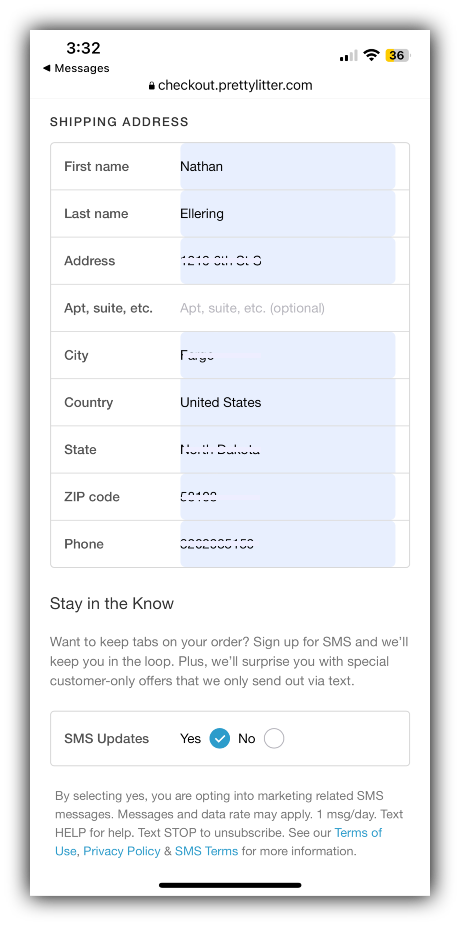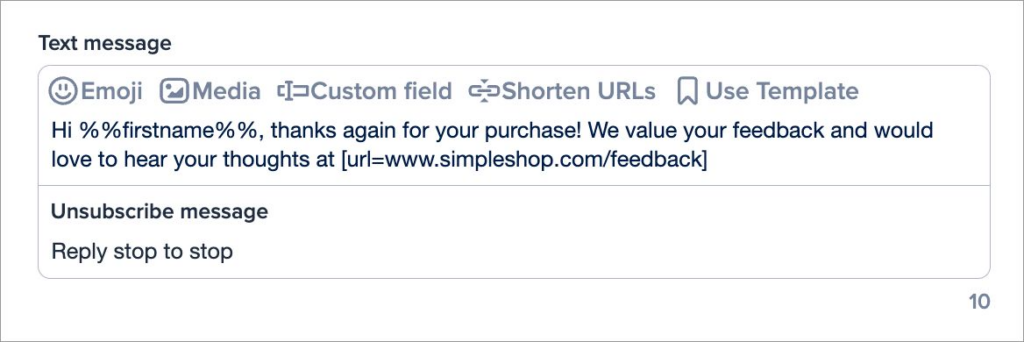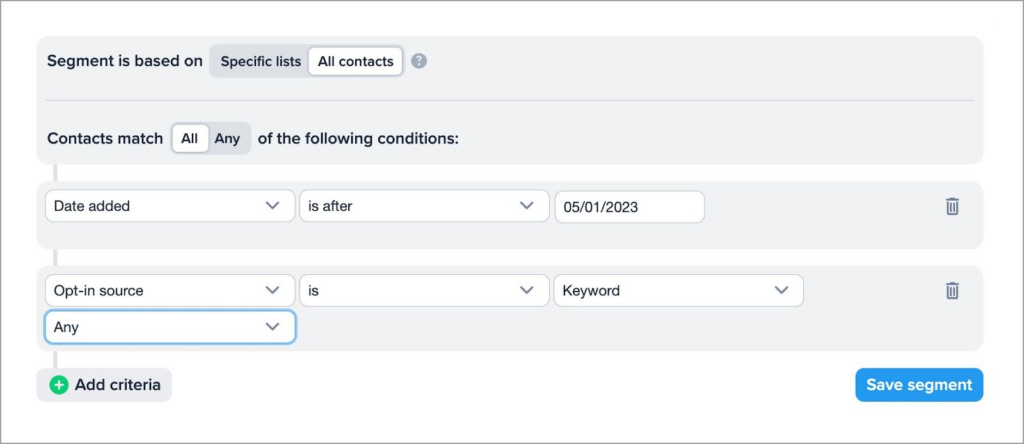How to collect phone numbers and grow your SMS marketing subscriber list
Learn how to build SMS marketing subscriber lists that attract your best customers and keep them engaged with your brand.
Every SMS marketing subscriber list starts with zero contacts.
Brands with hundreds or even thousands of contacts have figured out the recipe for a successful text marketing strategy:
Make it simple for people to subscribe, and provide them value from day one.
Still waiting for SMS subscribers to trickle in? I’ll share some ways real companies build profitable text messaging lists so you’ll have a roadmap for your own list.
SimpleTexting is SMS marketing software
What are SMS marketing subscriber lists?
Before we get into it, here’s what I mean when I say “SMS marketing subscriber lists”:
An SMS subscriber list is a group of text message contacts who’ve given you permission to send them text updates, like exclusive offers and company news.
You can use your SMS subscriber list to achieve your business’ goals—like increasing sales and customer loyalty—through mass texting and two-way messaging.
Why should you build an SMS subscriber list?
Your customers’ attention spans aren’t increasing, and your competition isn’t letting up on their promotional strategy.
You need a marketing channel that directly reaches your customers if you want to stand out.
That’s where building an SMS marketing subscriber list comes in. With 98% average open rates and 45% response rates, you won’t find a better return for your investment.
What are the benefits of SMS marketing?
- You have a direct line of communication with your audience, since you’re reaching them on their cell phones.
- It’s only legal if you have your contacts’ express written permission to send them promotional texts — so those who opt in to your messages want to hear from you.
- SMS industry compliance regulations help curb spam messages and increase trust with consumers.
- 80% of your contacts read their texts in five minutes or less, so you’ll see results quickly.
How do I create an SMS marketing list?
Ready to start your text marketing list? I’ll show you how to name your list and get people to subscribe.
1. Name your SMS marketing list
When creating a new list in your business texting platform, be specific. Include information about how your contacts are signing up and what kinds of messages they want to receive.
This way, you’ll keep your lists organized and will always know how to interact with the contacts.
Examples of good SMS marketing list names:
- “Social VIP Deals Club” for followers who want to receive exclusive promotions
- “Friday Yoga Class Attendees” for a gym’s weekly fitness class participants
- “Indianapolis Store Customers” for people who have signed up for your texting list at a specific business location
2. Choose your opt-in method
To invite people to join your list, you have a few options. Just remember that you need explicit permission to send marketing text messages to someone, and you can’t text someone who has given you their phone number for another purpose.
Compliant SMS list opt-in methods:
- Keywords
- Website forms
- Click-to-text buttons
- Paper forms (like sign-up and registration documents)
You can also import contacts manually, as long as they’ve agreed to your marketing text messages.
🎥 Watch our webinar about how to organize and manage your contact lists.
How to collect phone numbers for SMS marketing
Building your SMS subscriber list is essential for running a successful SMS marketing campaign. But how do you get people to sign up for your texting program in the first place? How do you collect phone numbers for SMS marketing in a way that is easy, effective, and compliant? In this section, we will share with you nine proven ways to collect mobile phone numbers for SMS marketing.
9 proven ways to grow your SMS marketing subscriber list:
- Use memorable keywords
- Include an incentive to grab contacts’ attention
- Create a VIP contact group
- Turn website visitors into subscribers with sign-up forms
- Add an invitation to your checkout page
- Bring email subscribers to your texting list
- Share with social media followers
- Advertise with signs and posters
- Host contests and giveaways
1. Ask people to text you a memorable keyword
It’s worth highlighting text-to-join keywords because they’re a surefire way to hook new contacts.
Here’s how SMS keywords work. As a business, you:
- Define a text-to-join keyword
- Advertise your keyword to your target audience, asking them to text that keyword to your business text number
- People text your number that keyword and automatically join your SMS marketing subscriber list
Be choosy with your keyword. You want one that’s creative and memorable so people are more likely to act on it. It’ll also increase the chances of them remembering your campaign down the line if they don’t subscribe immediately.
For example, if you’re a boutique dog groomer, clients will likely remember the keyword “VANITYFUR” instead of “GROOMINGSALON” because it’s short and a play-on-words.
Your keyword confirmation — which can be an SMS or MMS message — also gives you an excellent opportunity to welcome new text contacts right off the bat and reinforce your brand.
2. Incentivize people to subscribe
Where possible, offer a compelling incentive to subscribe to your text marketing list. You’re asking for access to their most personal device, so it’s only fair to return the gesture with a reward.
It explains why Toroe Eyewear was able to generate an additional $7,000 in revenue and increased their conversion rate by 200% — all thanks to a 10% off discount for new subscribers.

3. Create a text-only VIP group
We’re major advocates around here of providing exclusivity to help increase engagement and lower unsubscribe rates. What better way than to offer text subscriber-only promotions and content?
Position your texting program as a VIP text club, and send deals and information that your contacts can’t get anywhere else.
For example, you could host Q-and-As with experts in your industry every month or give contacts first dibs on new product launches.
4. Convert website visitors with signup forms
Attract SMS subscribers from your website with SimpleTexting’s Web Signup Form and on your mobile site with our Mobile Signup Widget. These tools allow visitors to conveniently subscribe as they browse your site (and you don’t need coding experience to install them).
5. Optimize your checkout experience to get subscribers
If you have an online store, your checkout page is prime real estate for an SMS list invitation. Shoppers who’ve reached that page clearly appreciate what you have to offer, and they’re already giving you their personal information to complete their purchase.

Under your order form’s phone number field, add a checkbox and TCPA-compliant disclaimer so shoppers can join your texting list.
💡 Pro tip: Include a coupon code on their next purchase in your automated welcome message to encourage future purchases.
6. Convert your email subscribers into text subscribers
In our 2024 SMS Marketing Survey, respondents said checking text messages is the most important activity they do on their phones. So even if you have an email marketing list, you may want to invite contacts to join your texting list so they’ll never miss an update.
Including email and SMS in your marketing campaigns can help reinforce your messaging and increase the likelihood that your contacts will respond.

7. Ask your social media followers to text you
Social media platforms are saturated with branded content, and algorithm updates can make engagement nearly nonexistent. Encourage your followers to subscribe to your texting list so they can receive exclusive content, deals, and company updates.
Building subscriber lists from social media followers can also help protect you if a social media platform goes offline (I’m looking at you, 2021 Facebook outage).
8. Use posters and signs to turn in-store visitors into SMS subscribers
If you have a physical storefront or office that’s open to the public, advertise your keyword on posters, flyers, and signs. I recommend creating a separate keyword for each business location so you can target those subscribers with relevant offers and event invites.
💡 Pro tip: Our free Graphic Generator makes it incredibly easy to create a graphic for your keyword that includes compliant promotional messaging.
9. Host contests to grow your SMS list
One of the fastest ways to grow your SMS list is to host a contest or giveaway. Use our Text-to-Win feature, which allows your audience to text a keyword to your business texting number for a chance to win. They’ll receive an autoresponse message letting them know that they’re in the running for the prize.
Pro tip: Make sure you nurture your text-to-win contestants with engaging content after the contest ends. Otherwise, you’ll have a swarm of unsubscribes after the fact.
7 SMS marketing subscriber list best practices
The process of building a contact list is different for every business, whether you’re text marketing for an e-commerce brand or sending SMS for a nonprofit.
With that said, there are a few universal best practices.
SMS marketing list best practices:
- Don’t buy phone number lists
- Enable double opt-in
- Provide opt-out instructions
- Help subscribers know what to expect
- Set text message frequency expectations
- Gather information to personalize text messages
- Segment text messages to personalize subscriber experiences
Shameless call-out: Using our tools and following the below tips, Artist Couture grew its contact list by 670% in one month.
1. Don’t buy phone number lists
It’s against the Telephone Consumer Protection Act (TCPA) to send marketing messages to a purchased list of contacts. The contacts haven’t consented to receive your text messages, and you could face fines of $500 to $1,500 per violation.
2. Enable double opt-in
As I mentioned earlier, you have to have explicit permission to send promotional text messages.
Take it a step further with a double opt-in process, which involves asking contacts to confirm that they consented to join your texting list. Not only do double opt ins give you the confidence that your SMS subscribers want to engage with your brand, but they can help protect you from TCPA violations.
3. Provide instructions on how to opt out
Sometimes people decide they don’t want to receive your texts anymore, and that’s okay.
Make it ridiculously simple to unsubscribe to your messages to prevent your contacts from reporting them as spam or blocking your number, which can affect your deliverability rates.
The CTIA — an organization that helps protect America’s wireless industry — advises businesses to provide clear opt-out instructions in their texts.
Examples of SMS opt-out instructions:
- “Text STOP to stop receiving these messages”
- “Text CANCEL to cancel your subscription”
- “Text UNSUBSCRIBE to be removed from this list”
Note: If you send texts with SimpleTexting, we recommend using the word “stop” since we’ll automatically unsubscribe contacts who text STOP to your number. Otherwise, you’d need to manually remove contacts from your lists. They can text “unstop” to re-subscribe to your messages.
4. Set expectations for what you’re sending
Setting expectations can help increase your texts’ response and click-through rates, since your contacts will look forward to what you have to say.
Tell contacts what kinds of content they’ll receive when they sign up for your texts, and remind them in your welcome message.
For instance, your call-to-action that invites them to subscribe may say, “Sign up for our texting list to receive exclusive deals and beauty advice!”
Your welcome message could include, “Thanks for subscribing! Be on the lookout for exclusive deals, flash sales, Q&As with our beauty experts, and more.”
5. Set message send frequency expectations
Another part of setting expectations is including your message sending frequency. Your contacts will be more receptive to your texts if they know how many you plan to send and how often.
The CTIA recommends including your messaging frequency in your compliance message (the automated message sent after your first text to a new contact).
6. Gather contact data for personalization
Your customers know that brands have data about them, and they expect a certain level of personalization in their interactions.
In fact, McKinsey’s Next in Personalization 2021 Report found that 76% of consumers are more likely to purchase from brands that personalize.
If you don’t already have information about your SMS contacts, like their first names and location, all you have to do is ask. Our Data Collection tool can help you gather, store, and use your contacts’ data to enhance their experience and strengthen your relationship with them.
Then, use custom fields to insert the information into your text message campaigns. Here’s what a campaign with your contacts’ first name might look like:

And here’s what your contact would see:
7. Segment text message sends based on location, behavior, and more
Speaking of personalization, did you know that you can group your contacts by their demographics, interests, and behaviors?
In the SMS world, this is called segmentation, and it can make your text message campaigns even more relevant to your contacts (which can increase how much they engage with your messages).
To create segments in SimpleTexting’s SMS marketing platform, you can navigate to the Segments tab under Contacts and select criteria that matches the contact groups you want to create.

SMS marketing subscriber list FAQs
What types of SMS lists are there?
How can I send text messages to my contacts list?
How should I segment my SMS subscriber list?
What is SMS marketing with an example?
Can you buy SMS marketing lists?
This piece was originally published on August 4, 2020. It was most refreshed and repurposed on June 1, 2023. It was updated again September 21, 2023. Alfredo Salkeld and Nathan Ellering contributed to this piece.